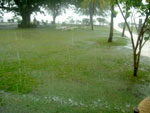
Uncertainty in flood inundation models
Recent research
Flood inundation models play a central role in both real-time flood forecasting and in floodplain mapping. In flood forecasting, inundation models should be as precise as possible to predict the approach of a flood correctly as well as to avoid false alarms. Flood mapping has to be accurate for a variety of reasons including decision making for local planning or the insurance industry. A full understanding of the model and the uncertainty in the modelling strategy is therefore important.
Sources of Uncertainty in flood inundation models
Every flood inundation model will be an incomplete representation of reality as a result of multiple sources of uncertainty. We may distinguish the primary sources of uncertainty as follows:
- choice of model structure as a simplification of reality (e.g. 1D or 2D flood inundation model or various representations of internal structures such as bridges)
- Nnmerical approximations in solution of equations defined in model structure
- dfinition of boundary conditions, including input forcing data
- choice of effective parameter values, including scaling and incommensurability effects
Flood events which have been studied within the FRIEND program
| Location | Date |
Type of Data |
Publication |
Usti nad Orlici (Czech Republic) |
1997 |
Geometry, Flood extent & 26 level observations |
|
River Morava (Czech Republic) |
1997 |
Geometry, maximum level observations |
Key Findings:
- Model parameters are effective parameters (Pappenberger et al., 2005a)
- Distributed observations of levels in floodplains have been shown most effective in constraining the uncertainty of flood inundation models (Werner et al., 2005a)
- Observations of flood extent in large events where flood extent is constrained by embankments and steep valley sides may not be suitable enough to discriminate between various model structures (Werner et al., 2005a).
- Sensitivity analysis of model performance against the calibration data shows that as the number of land use classes increases, sensitivity to these roughness values decreases (Werner et al., 2005b).
- Sensitivity to the uncertainty to the upstream boundary depends on the model structure chosen (Pappenberger et al., 2005b; Pappenberger et al., in press).
- Internal structures such as bridges can have a profound effect on model performance (Pappenberger et al., in press)
- Under certain circumstances no parameter set or model implementation that fulfils all evaluation criteria can be established. We propose four different approaches to this problem: closer investigation of anomalies; introduction of local parameters; increasing the size of acceptable error bounds; and resorting to local model evaluation. Moreover, we show that it can be advantageous to decouple the classification into behavioural and non-behavioural model data/parameter sets from the calculation of uncertainty bounds. (Pappenberger et al., in press)
Conclusions
Uncertainty analysis of flood inundation models is essential to fully understand the limitations of the predictions and inundation models and estimation of flood risk. However, there is no readily available guidance about how to do uncertainty analysis of flood inundation models. (Pappenberger and Beven, in review). Future research in uncertainty in flood inundation models will have to concentrate on this topic.
For more information contact: Florian Pappenberger and Micha Werner

|
© 2016 EURO-FRIEND
|
Top 
|


River Trent, Nottingham, UK

Heavy rain, Penang, Malaysia
(06.11.2007, 95 KB)
 European Water Archive
European Water Archive Satellite derived snow
Satellite derived snow Uncertainty in flood models
Uncertainty in flood models